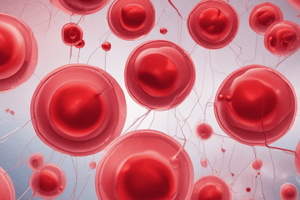Podcast
Questions and Answers
What determines whether an individual is Rh positive or Rh negative?
What determines whether an individual is Rh positive or Rh negative?
- The overall platelet count
- The presence or absence of the Rh antigen (correct)
- The functionality of the clotting cascade
- The level of hemoglobin in the blood
Which diagnostic test specifically involves examining blood cells under a microscope?
Which diagnostic test specifically involves examining blood cells under a microscope?
- Peripheral blood smear (correct)
- Complete Blood Count (CBC)
- Coagulation studies
- Bone marrow biopsy
What is the primary purpose of careful blood typing and cross-matching before a blood transfusion?
What is the primary purpose of careful blood typing and cross-matching before a blood transfusion?
- To ensure a higher hemoglobin level post-transfusion
- To avoid complications due to blood incompatibility (correct)
- To optimize the nutritional factors in the blood
- To assess the patient's overall health before transfusion
What is a key benefit of Hematopoietic Stem Cell Transplantation (HSCT)?
What is a key benefit of Hematopoietic Stem Cell Transplantation (HSCT)?
Which factor can affect blood component levels and functions as individuals age?
Which factor can affect blood component levels and functions as individuals age?
What is the primary function of red blood cells?
What is the primary function of red blood cells?
Which condition is characterized by a deficiency of red blood cells or hemoglobin?
Which condition is characterized by a deficiency of red blood cells or hemoglobin?
What triggers the formation of a platelet plug?
What triggers the formation of a platelet plug?
Which type of white blood cell is primarily involved in fighting infections?
Which type of white blood cell is primarily involved in fighting infections?
In the ABO blood group system, type O blood is characterized by:
In the ABO blood group system, type O blood is characterized by:
Which of the following conditions can lead to an increased risk of bleeding?
Which of the following conditions can lead to an increased risk of bleeding?
What is the primary role of hemoglobin in red blood cells?
What is the primary role of hemoglobin in red blood cells?
Leukemias are primarily characterized by:
Leukemias are primarily characterized by:
Flashcards
Complete Blood Count (CBC)
Complete Blood Count (CBC)
A blood test measuring red blood cells, white blood cells, platelets, hemoglobin, and hematocrit.
Peripheral Blood Smear
Peripheral Blood Smear
The examination of a blood sample under a microscope to identify abnormalities in blood cell shape and structure.
Hematopoietic Stem Cell Transplantation (HSCT)
Hematopoietic Stem Cell Transplantation (HSCT)
The process of replacing diseased bone marrow stem cells with healthy ones.
Rh Blood Group System
Rh Blood Group System
Signup and view all the flashcards
Blood Transfusion
Blood Transfusion
Signup and view all the flashcards
What is Hematology?
What is Hematology?
Signup and view all the flashcards
What is Plasma?
What is Plasma?
Signup and view all the flashcards
What are Erythrocytes?
What are Erythrocytes?
Signup and view all the flashcards
What are Leukocytes?
What are Leukocytes?
Signup and view all the flashcards
Describe Anemia.
Describe Anemia.
Signup and view all the flashcards
What is Hemostasis?
What is Hemostasis?
Signup and view all the flashcards
What is Blood Typing?
What is Blood Typing?
Signup and view all the flashcards
Define Leukemia.
Define Leukemia.
Signup and view all the flashcards
Study Notes
Hematology
- Hematology is the medical study of blood, blood-forming tissues, and blood disorders.
Blood Components
- Blood is a complex tissue composed of:
- Plasma: A liquid containing water, proteins (albumin, globulins, fibrinogen), electrolytes (sodium, potassium, calcium), nutrients, and waste.
- Red blood cells (erythrocytes): Transport oxygen, containing hemoglobin (iron-binding protein).
- White blood cells (leukocytes): Part of the immune system, fighting infection. Types include neutrophils, lymphocytes, monocytes, eosinophils, and basophils.
- Platelets (thrombocytes): Crucial for blood clotting, forming plugs at injury sites.
Red Blood Cell Disorders
- Anemia: Low red blood cell count or hemoglobin, caused by iron deficiency, vitamin B12 deficiency, or genetics.
- Polycythemia: Excessive red blood cells, increasing blood thickness and clotting risk.
White Blood Cell Disorders
- Leukemias: Cancers of blood-forming tissues, causing uncontrolled white blood cell growth. Different types exist with varying outcomes.
- Lymphomas: Cancers of the lymphatic system, often presenting with swollen lymph nodes.
- Infectious Mononucleosis: Epstein-Barr virus infection, marked by fatigue, fever, sore throat, and swollen nodes.
Platelet Disorders
- Thrombocytopenia: Low platelet count, increasing bleeding risk.
- Thrombocytosis: High platelet count, increasing clotting risk.
Hemostasis
- Stopping bleeding involves a cascade:
- Vascular spasm: Blood vessel constriction at the injury site.
- Platelet plug formation: Platelets adhering to the damaged vessel wall.
- Coagulation: Fibrin clot formation to reinforce the platelet plug.
Blood Typing
- Blood types are based on antigens on red blood cells.
- ABO system: Individuals are A, B, AB, or O based on A and B antigen presence.
- Rh system: Rh positive or negative based on Rh antigen presence.
Diagnostic Tests
- Complete Blood Count (CBC): Measures red blood cell count, white blood cell count, platelet count, hemoglobin, and hematocrit.
- Peripheral blood smear: Microscopy to detect abnormalities in blood cell shapes.
- Bone marrow biopsy: Examines the bone marrow (blood cell production site) for abnormalities.
- Coagulation studies: Assess clotting cascade function for bleeding/clotting disorders.
Blood Transfusions
- Blood or component transfusions treat blood disorders and loss.
- Careful typing and cross-matching prevent transfusion reactions.
Hematopoietic Stem Cell Transplantation (HSCT)
- HSCT is potential treatment for cancers and certain inherited blood disorders.
- Healthy stem cells replace diseased ones in the bone marrow.
Other Important Considerations
- Age-related changes affect blood component levels and function.
- Nutrition is key for blood cell production and function.
- Lifestyle (diet, exercise, health) impacts blood health.
- Genetic factors influence blood disorder risk.
Studying That Suits You
Use AI to generate personalized quizzes and flashcards to suit your learning preferences.




